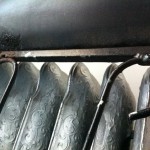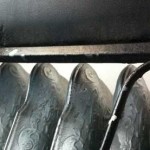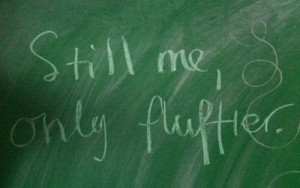 Chris says I line everything up against the wall like I’m staging an execution.
Chris says I line everything up against the wall like I’m staging an execution.
The other evening he walked through the front door, into the bedroom where I stood changing the duvet cover, and, coat still on, started picking up and moving things around on his dressertop with pronounced deliberation.
“Breathing room!” he hollered dramatically, exhaled with satisfaction, and only then de-jacketed to begin the work of winding down.
— A moment: lest I risk casting my hero here as anal retental villain, I should own upfront that the seemingly innocuous things mentioned so fleetingly in scene above aren’t exactly as innocent as they might appear. They weren’t in fact just sitting on top of the dresser, all, you know, innocent and random.No, they were in fact stating my presence and command in some subtle way. They had indeed been placed. I’d arrayed them for my own inner notion of display, whether consciously or no, in the course of tidying up the house.
To me this snapshot moment illustrates the visual surface tension continually at play within our home and life together: my darling a trained visual artist in several media and I for my part more and more actively embracing self-identification as visual+verbal designer. So we end up tugging back and forth a bit, negotiating the construction of shared space in mostly gentle and small-scale physical ways.
(My honey’s outburst on this day did, of course, as well express natural relief upon homecoming after a long workday, a literal request for what he most needed right then: air and space. The big working world out yonder is a tempestuous and trying arena and civic government most cussedly so. The daily trials wear a body down, torque it by situations of engagement and sortie into shapes all out of alignment. The by-contrast-snowglobe where I currently reside is a topic for another post. Here I’ll restrict myself to the subject of choreographing physical objects in space.)
To be fair, he may have a valid point about my up-against-the-wall organizational bias (ahem, pill bottles). Thought the specific dressertop lockstep that provoked his outburst had more to do with dusting than intentional design–yet this pattern been noted as a tic, so I’m on the lookout for tendency.
Recently I mentioned to an art school-trained designer friend and Etsy shop proprietor my ever-so-slooooowly developing scheme to sell vintage stuff etcetera online. Prompted to assist, she pulled up an array of relevant and tidy product photography by way of example, mentioning in passing the Rule of Thirds. This rang a distant little rusty bell, but it took Wikipedia to clue me in a bit more concretely.
The Rule of Thirds dates from an occasion over two centuries ago when one John Thomas Smith, engraver, outlined it as his own device of ideal proportion while discussing design elements in landscape art:
Two distinct, equal lights, should never appear in the same picture : One should be principal, and the rest sub-ordinate, both in dimension and degree : Unequal parts and gradations lead the attention easily from part to part, while parts of equal appearance hold it awkwardly suspended…Analogous to this “Rule of thirds“, (if I may be allowed so to call it) I have presumed to think that, in connecting or in breaking the various lines of a picture, it would likewise be a good rule to do it, in general… I have found the ratio of about two thirds to one third, or of one to two, a much better and more harmonizing proportion. (1797)
In the original Smith launches into in raptures of fraction and orderly division most likely common to a thinker in the late Enlightenment, though today it reads as somewhat manically fastidious. Consonant, all the same, with a fella staking out ideological turf in naming and defining the rules of art.
I should think myself honored by the opinion of any gentleman on this point; but until I shall be better informed, shall conclude this general proportion of two and one to be the most pictoresque medium in all cases.
Q.E.D., motherfuckers.
For my own part I have, upon reflection a possibly relevant recollection. Back around 1987 (o, the predigital days of the 20th centurie…) I took a black and white photo darkroom class at the local community college while on official leave from “real” school. One day I was immensely gratified to come to class and find the teacher using one of my shots the day’s instructive lesson. He was, as I recall, a middle aged (though probably little older than I am myself now) white guy who favored short sleeved button-down shirts from Sears. His name escapes me now, although the lesson of that day certainly made its mark. He held up before the class a still life I’d arranged of a pyramidal alignment of minor kitchen objects– salt cellar, onion, spoon, bowl– and illustrated for us how the visual structure conspired to move the eye dynamically through space within a two dimensional context. Now that I think back on it, his lesson that day strikes me now as fueled fundamentally by the sort of asymmetrical design aesthetic outlined by Smith in his Rule of Thirds.
The content of my photo class picture probably causes little surprise for anyone with passing acquaintance recent Navelgazer posting.The plain fact is I’ve always made these odd conglomerations of the whatnots, though the activity has ramped up quite a bit of late as it evolves into some more conscious endeavor I’m still struggling to name. Still and always impulse is reflexive, reaching out to arrange things just so. Leaning toward some inner knell of balance that is, for me, markedly intuitive. I’d very much like to say, “Rules schmules, I just fiddle till it feels right”– but this is surely disingenuous. I’ve had schooling up to here, and no doubt my perspective is framed by all manner of foundational and structural beliefs I’m not even fully cognizant of myself. All the same I tend to resent, somewhat, the pretensions of self-proclaimed artistic authorities, naming their Rules and so forth. Though I guess I get the urge to quantify for a critical and rationalistic audience and activity, art, that is at heart mysteriously passionate, unknowable and wild, that creative life force. Rules are just so much logical scaffolding erected to polish windows on the real edifice of the work itself.




